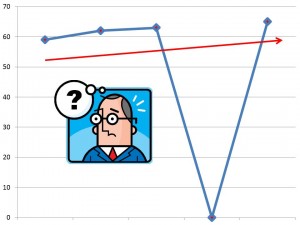 Averaging student grades is an inaccurate way of measuring what they’ve achieved in class. At the end of the semester, do you add up all the points a student has earned throughout the term and then divide that number by the total amount of points possible to determine the student’s overall score? If you do, I encourage you to stop and adopt the practice of analyzing trends in student performance to determine their final G.P.A. First, let’s use an analogy to explain why averaging is a disservice to our students.
Averaging student grades is an inaccurate way of measuring what they’ve achieved in class. At the end of the semester, do you add up all the points a student has earned throughout the term and then divide that number by the total amount of points possible to determine the student’s overall score? If you do, I encourage you to stop and adopt the practice of analyzing trends in student performance to determine their final G.P.A. First, let’s use an analogy to explain why averaging is a disservice to our students.
Pretend you’re a meteorologist charged with the task of reporting the average high temperature for 5 days in Traverse City during the spring term. On Monday you record a high of 59°, on Tuesday you record a high of 62°, on Wednesday a high of 63°, but on Thursday you drop the ball. You’re so busy with other obligations that you to forget to take the day’s high temperature. On Friday, you rebound strongly and record a high temperature of 65° – what do you do now?
Do you add in a zero for the high temperature on Thursday like a lot of instructors would for a missing assignment? If you did, the average high temperature for the week would be about 50° and undeniably inaccurate. In this instance, adding in the “killer zero” falsifies your records and the same thing happens in the instructor’s grade book. Fortunately, there is a better option for determining the average high temperature for the week.
Obviously, the temperature during this spring week was trending upward – the days got warmer as the week progressed. By analyzing the trend in weather, the meteorologist can safely say that Thursday was probably in the low 60s and the average high temperature for the week was probably in the low 60s too. Students are just like this meteorologist (they drop the ball, they have bad days, and they forget to turn in their work), but we, as instructors, can protect the sanctity of our grade books and even retain more students by avoiding the “killer zero” and analyzing trends in grades instead of averaging them together. A lot of my thoughts about this topic originated from Rick Wormeli’s Fair Isn’t Always Equal.


Ryan,
This is Mark Shelley for Yavapai College in Prescott, AZ. Glad to see you all are doing this! It’s been great on our campus.
I could agree with you more on the nonsense of averaging grades. Aren’t we looking for improvement and completion, not just a stat?! I try to take into account that “life happens” and give students a built in “fudge factor” in their grades. But I DO insist complete 90% of the work (in a reasonable time frame) to pass the course. Students are so conditioned to “averages,” etc., it takes them a while to catch on. But once they do, they seem to appreciate and “get” it. 🙂
Keep up the good work!
Mark
Mark,
Thanks for replying to my post. I agree that there has to be a healthy balance between expectations for completing assignments as a course expectation and looking at grading trends instead of averaging. It’s my experience that students really do appreciate this a great deal. We teach to help students learn. Why then would we average their first score in with their last score to determine a grade that represents what they’ve learned? It doesn’t make sense. Isn’t their last score, their most recent assessment of the skills they’ve picked up in course, the best way to determine what they’ve learned? Happy Halloween to all in Prescott, AZ!
Ryan
Thanks for taking part in this blog Ryan. I’d like to see how you explain the grading scale in your syllabus. I totally agree with the philosophy and would like to see how you work in the fudge factor to make it acceptable to the “bean counters” in anatomy and physiology.
Keith
Hi Keith,
Thanks for reading my post. I actually present a straight forward grading scale (94% and up is a 4.0 and so on). I have 1000 points possible in a term and I use the Moodle grade book to keep track of their scores. What I tell my students from day 1, however, is that the grade book and the “beans” (or points) are just a tool to help me determine their score. The score out of 1000 definitely counts, but I’m straight forward by telling them that continual improvement and their attempts to better themselves also play a factor in their final score. I hope this helps to paint a picture of my approach.